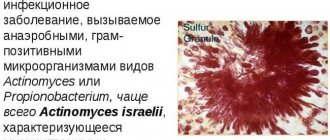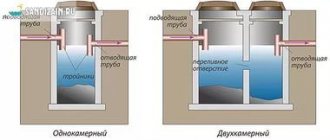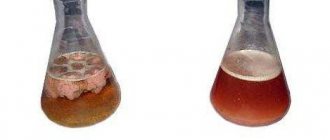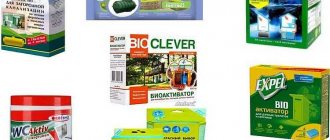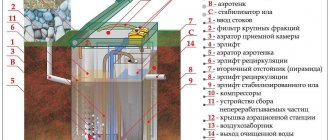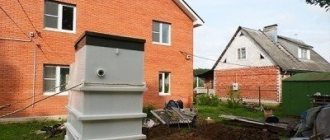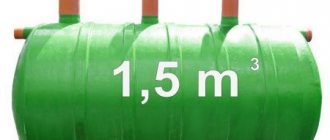Forms of biological products for cesspools
Cesspool bacteria are cultures grown in a nutrient medium that feed on organic matter. Depending on the form of the drug, they are dried (powders and tablets) or made into an aqueous solution. In the preparation, the bacteria are in a dormant state; certain actions are required to activate them. They depend on the form of release and are written in detail on the packaging. Accurate execution of instructions is very important to obtain results.
Regardless of the form of release, most drugs can be used to enhance processing in septic tanks. Dosages change (septic tanks usually have a larger volume than a pit) and the method of “delivery” to the destination. In the case of home drains, bacteria can also unclog the drain. To do this, the drug is poured into the sewer and not used for at least 24 hours. During this time, microorganisms dissolve fats and stuck waste and the water begins to drain better. This is a good replacement for chemicals, especially for septic tanks or for VOCs, because after cleaning with chemicals, the quality of processing noticeably decreases. Otherwise, you will simply add another portion of bacteria, which will only make the wastewater cleaner.
Bacteria for cesspools are released in three types of preparations:
- dosed powders;
- liquid solutions;
- in the form of tablets.
In principle, the form of release does not matter
The number of microorganisms, their condition and degree of “freshness” are important. All drugs have a limited shelf life
Be sure to check the dates when purchasing. The later the date, the worse - the bacteria could die.
Manufacturers also standardize storage conditions. Usually this is temperature - the drug should not freeze (in theory, it should not even cool below +10°C). It is impossible to know whether the storage conditions were observed. You can only believe it empirically - if the drug does not work, the reason may be that the bacteria died as a result of improper storage.
What to do with bacteria in powder form
Powdered septic tank products occupy the majority of the market. It's convenient: they are packaged in small bags. You usually need to pour out one sachet at a time; more is required only for the initial (first) load. There may be powder inside, or there may be granules - it varies from manufacturer to manufacturer.
Method of using bacteria for cesspools in powder form
As a rule, the powder must be diluted in water, left for a while, and then poured into the cesspool.
Liquid solution for cesspools
This is a concentrated solution of bacteria. Just like dry preparations, concentrates must be “fresh” and stored at above-zero temperatures. Overheating is also not allowed - the upper limit of viability of most bacteria is 40-45°C.
Liquid products usually just pour out
Using sump fluid is even easier. All you need to do is measure the required volume (set in milliliters or caps) and pour it into the hole. Sometimes it is necessary to dilute the drug in water and then pour it away. Everything is clearly stated in the instructions.
Toilet tablets
This type of septic tank bacteria is formed into small discs, shaped like tablets, only with a much larger diameter. There is a certain amount of them in a bag or tube. Each tablet is packaged in plastic film. Before adding the cesspool, the shell is removed and the product is thrown inside.
Tablets for country toilets are simply thrown inside
If the home sewer system is made from a septic tank, throw the tablet into the toilet, wait until it dissolves, and then flush the water.
Rating of biological products and cleaners for septic tanks and country toilets
Useful information for our readers-dacha residents: a list of liquid and powder products for cleaning autonomous sewer systems.
Highlight:
- Biological products for septic tanks and cesspools - a powdered product that accelerates the decomposition of waste in the country toilet;
- Cleaners for septic tanks and country toilets - a liquid drain cleaner containing special bacteria;
- Biogranules for rapid waste decomposition;
- Concentrated biological preparation for wastewater treatment - neutralizes aggressive chemicals that enter waste from the use of washing powders, detergents, etc.;
- Bioactivator for septic tanks - ensures rapid decomposition of waste.
Such products contain natural microorganisms (bacteria) that decompose fossils, fats, paper, and eliminate unpleasant odors in country toilets.
To select a suitable product, follow the link>>>
There are DISCOUNTS for our readers in the LEROY MERLIN store.
Buying online is cheaper than buying in a store (online prices are lower)! It is very profitable, convenient and safe: you can buy goods without leaving your home or visiting a store. All purchases will be delivered to your home.
In addition, in the online store, on each product page you can see the exact characteristics and real customer reviews.
Possible problems
Nowadays you can find various biological preparations that are needed for use in installed septic tanks and toilets in the country. However, all of them are needed for recycling organic waste, neutralizing it, eliminating unpleasant odors, and reducing the volume of sludge.
If the liquid level in the pit is low, microbacteria will not be able to fully develop and work. It is the presence of the required volume of moisture that is a condition for a good result. After all, the life process of microbacteria depends on the conditions in which they exist. And the norm for them is a maximum liquid environment.
So:
- Ideally, the water level in the cesspool is at least 20 mm higher than the amount of solid waste.
- If this is not the case, then before adding the product you need to pour 20 liters of clean water into the hole.
- Before adding, the product must be prepared as indicated in the description of the drug.
Before purchasing any bacteria, you should consult with professionals.
Attention! After the product is added to the pit, it is necessary to monitor the water level for 2-3 days. If it shrinks, you should pour in another 20 liters of water.
Frequency of work and price
The intervention of specialists in caring for a septic tank is required at least twice a year, sometimes once a year for periodic residences. At the same time, the degree of concentration of sludge sediment is monitored periodically (once a quarter). If the concentration exceeds 70%, the waste material is partially pumped out. After repeated pumping, the chamber is cleaned and washed with water.
In addition, only qualified workers are able to quickly and correctly disassemble the station’s components, remove and clean filters for large fractions, and “catcher trees” for non-recyclable substances. It is necessary to periodically check the performance of pumps and compressors, diagnose and replace gaskets and membranes of the aerator. All these and many other works constitute professional septic tank maintenance. The cost of services at LOS24 is affordable and depends on the station model. So, for example, for the maintenance of a Unilos Astra 5 septic tank, the base price is 4 thousand rubles. A number of nuances influence the increase in cost - from the complexity of additional repair work to the remoteness of the object from St. Petersburg.
By contacting our company, you get many benefits: saving time, maintaining comfort and maintaining the septic tank at a high level, ensuring its reliable and efficient operation without repair costs. Call, consult, order!
| Station model | Service cost | Cost of emergency departure* |
| 3 | 3500 rub. | 2500 rub. |
| 5 | 4000 rub. | 2500 rub. |
| 8 | 4500 rub. | 3000 rub. |
| 10 | 5500 rub. | 3500 rub. |
| 15 | 6500 rub. | 4500 rub. |
| 20 | 8500 rub. | 5000 rub. |
| 30 | 10,000 rub. | 6000 rub. |
| 40 | 12500 rub. | 6500 rub. |
| 50 | 14,000 rub. | 7000 rub. |
| 75 | 18500 rub. | 8500 rub. |
| 100 | 22500 rub. | 10500 rub. |
| 150 | 39,000 rub. | 15,000 rub. |
Return to list of services
How and what bacteria purify water
The use of chemicals to clean local sewage systems has been actively used in ancient times. Such drugs can be used at any temperature (the main thing is that the contents of the septic tank do not freeze).
Bacteria for cesspools are relatively inexpensive
They are not afraid:
- Hard water;
- Chlorine impurities;
- Other antiseptic substances.
But chemicals negatively affect both the sewer system itself (especially those made of metal) and the atmosphere. Today, products based on active microscopic organisms are used to process wastewater.
The first group is anaerobic microorganisms, which are included in biological preparations for wastewater treatment. Their common feature is the ability to survive without oxygen. They are used as a means for servicing sewers and septic tanks.
For microbacteria to work well, they need:
- Carbon;
- Sulfates;
- Nitrates.
The second group is aerobic protozoan microorganisms that require oxygen to live. The drains themselves do not contain air, so in order for bacteria to clean the water, an oxygen supply from the compressor is needed.
When to use a cesspool cleaner
Failure in the operation of the local sewage system can be indicated by the stench spreading around the treatment plant, as well as deterioration in the quality of wastewater at the exit from the treatment plant.
This can occur due to the death of active biomass, which occurs for several reasons:
- when chemicals that are lethal to microorganisms (antibiotics, chlorine-containing cleaners, etc.) enter drains;
- as a result of exposure to low temperatures at the station, for example, in the absence of insulation of the tank;
- stopping for a long time the flow of waste into the sewer system, which is food for bacteria.
Also, wastewater treatment may be inadequate in the first weeks after the commissioning of the treatment plant.
In all the described cases, a specially selected product for septic tanks will help restore the operation of the local sewage system. There are bacterial agents that will reduce the amount of sediment in the settling chamber of a septic tank, cesspools and country toilets.
Which bioactivator should I buy for the TANK septic tank?
Such treatment plants are chosen by the owners of small and medium-sized country houses, where from 3 to 6-8 people live (on a permanent basis). Junior models are created on the basis of a two-chamber design with a total volume of 1 to 2 m3. Older models come in two-chamber and 3-chamber types, with a total volume of 2.5 to 4 cubic meters.
TANK septic tanks are designed for aerobic and anaerobic fermentation of wastewater. Primary clarification of sewage water occurs in the first gravity cleaning chamber. Anaerobic bacteria that can survive in the bottom layer come in handy here. In the second chamber, aerobic decomposition of the settled wastewater occurs, which continues in the third post-treatment tank and in the infiltration module.
If we analyze the manufacturers’ proposals, the following drugs can be recommended for 1- or 2-cubic-meter TANK septic tanks:
| Doctor Robik 109 is a universal option based on anaerobic and aerobic cultures that remains active for a month. One sachet of Robik 109 is designed for a volume of 1500-2000 liters for 1 month. The drug is simply poured into the toilet and flushed. It is not recommended to use chlorine-containing cleaning products. |
| The drug Roetech K-37, formulated on the basis of anaerobic cultures that support fermentation even in homemade, single-chamber septic tanks. The product is effective for 6 months, serving a sump volume of up to 2000 liters. Roetech K-37 is inserted into the toilet - the entire bottle is poured out - after which you need to flush it twice. |
For septic tank models TANK 3 and TANK 4, it is better to choose drugs
| BioExpert 2 tablets - this drug decomposes not only organic matter, but also cellulose, cleaning the septic tank chambers even from grease film and soap scum. Two tablets are designed for a volume of up to 8000 liters for 1 month. They continue to act for a month. The method of administration is to flush it into the toilet and, after waiting for the tablet to dissolve in the water seal, flush it. |
| Set DR-365-1, which includes a one-year supply of the liquid drug Doctor Robik 309 and a 12-month set of sachets Doctor Robik 109. The liquid product is poured into the toilet at the start of the septic tank, after which it is thrown into the primary chamber of the sump, 2 bags per month . Moreover, for septic tanks with a volume of up to 4 cubic meters you will have to buy two sets of DR-365-1. |
The manufacturer of septic tanks TANK states the need for annual cleaning of sump tanks, however, according to the manufacturer, the monthly use of bacteria allows you to increase the frequency of pumping to 3-4 years.
Brief overview of popular tools
With regular use, it extends the life of the septic tank, toilet, and cesspool. The greatest activity of bacteria is observed at pH=5-8.5. Wastewater processed using Vodogray can be used for watering garden crops, it is odorless and absolutely harmless. The sludge formed as a result of processing is neutral in its chemical composition and does not exceed 3% of the total amount of processed waste.
The manufacturer does not recommend pouring water containing household chemicals into the sewer a day before and the same amount of time after throwing the drug into the pit. In the future, you can use both a washing machine and a dishwasher, since the “Vodograi” preparation is adapted to chemicals used in everyday life.
The Vodogray preparation contains aerobic microorganisms, so the septic tank hatch must have a ventilation window through which fresh air will enter the chamber.
Frequency of use – monthly. Vodogray cannot be used together with products that remove blockages in pipes.
Actively processes sewage and other organic matter. Before use, the drug is diluted in warm, unboiled water, and then poured into a cesspool. The unpleasant odor disappears within 2 weeks after starting use. The complete waste recycling cycle is one month. The product is harmless to people and the environment. For 1 m3 of sewage, take 75 grams of bacteria (1 sachet). An increased dosage (150 grams) is used when draining water containing household chemicals.
“Cleaning power” allows you to restore the drainage properties of the bottom of the cesspool.
Recycled wastewater does not pollute soil and groundwater. Using the drug you can also free sewer pipes from build-up.
Enzymes and living microorganisms replace sewer trucks
The product effectively combats unpleasant odors and contains catalyst additives that speed up the waste disposal process.
To activate bacteria, use unfiltered water that has been left standing for 24 hours. If the product is not poured into the septic tank, but into the sink or toilet, the pipes should be washed with 30 liters of water so that the maximum number of bacteria can reach the septic tank chamber.
Owners of private houses do not have to worry about the condition of the cesspool; special bacteria will do all the “dirty work” - process the waste and eliminate the unpleasant odor. In order not to disturb the biological balance of the system, it is worth switching to household cleaning products labeled “bio”.
Bacteria for septic tanks ASTRA series
The ASTRA autonomous waste water treatment system serves from 5 to 30 users. Aerobic fermentation takes place inside a multi-chamber septic tank, spurred on by Japanese Techno Takatsuki or Secoh Sangyo compressors.
The insulated body of ASTRA septic tanks makes it possible to use the energy of decomposing biomass to maintain a comfortable temperature, so such systems operate with the same efficiency in both winter and summer.
The presence of film filters, aerators and airlifts ensures continuous aerobic decomposition of sludge, especially when appropriate bacteria are introduced into the septic tank in the required dosage.
For septic tanks ASTRA 3, 5 and 8, the following types of bacteria can be recommended:
| Bioactivator BioSept 50 – one package contains 2 sachets, designed for a volume of up to two cubic meters. Thanks to the large proportion of aerobic bacteria, BioSept 50 gives the first result 2 hours after administration, however, this cocktail will also work in the bottom layer, where there is practically no oxygen. The bacteria remain active for 2 weeks. Therefore, for each cubic meter of septic tank volume, you need to spend at least two sachets per month. The introduction of culture is carried out according to a simplified scheme - into the toilet. |
| BioExpert capsules 4 tablets - this composition is designed for a month of work in a septic tank with a volume of up to 12,000 liters, so for significantly smaller sedimentation tanks from the ASTRA 3, 5 and 8 series, one package is enough for four whole months of work. Users who live in a country house on a permanent basis will buy 3-4 packages of BioExpert 4 per year. For seasonal summer residents, one package is enough. The tablets are dissolved in the toilet water seal or dumped into the first chamber of the septic tank. |
ASTRA 10 and 15 deep cleaning stations require the following preparations:
| Bioactivator BioSept 600, a loading dose of which (all 24 sachets) requires servicing a sump tank with a volume of up to 24,000 liters. One package of BioSept 600 will serve septic tanks ASTRA 10 and 15 for 2-3 months, since 2 sachets are needed per 1 m3. Soluble bags are flushed into the toilet or septic tank. |
Autonomous sewer systems like ASTRA 30 require bacteria such as:
| BioExpert capsules 12 tablets containing biologically active microorganisms and starting enzymes that facilitate the growth of bacterial colonies in the initial period. One tablet serves septic tanks with a volume of up to 3 cubic meters, so a package of 12 tablets is enough for 3-4 months of uninterrupted operation of the septic tank. The tablets can be flushed down the toilet (3-4 pieces at a time) or into the inspection hatch of the septic tank. |
Types of bioactivators
When choosing the optimal product for a septic tank, you should know that there are several different types that differ not only in capabilities, but also in the need for certain conditions, without which they will not work and will not give the desired effect.
Therefore, it is worth knowing exactly the difference between bacteria for a septic tank in order to select the most optimal organisms for your treatment plant that can work in this particular environment.
As for the features of use, the septic tank will work as efficiently as possible if bacteria are frequently used and fed with bioactivators. What to add to the septic tank for the winter to prevent it from freezing? And here bioactivators will come to the rescue: if in the winter months the owners are not on the site, then before the start of the summer season it is definitely worth purchasing them. The septic tank, so to speak, needs to be constantly “fed”. Using the product is very simple - just pour it into the drain, sometimes it needs to be diluted beforehand.
Application of bioactivators
Among modern bioactivators, it is worth highlighting separately anaerobic bacteria for septic tanks and so-called aerobic ones. In the first case, the presence of air in the septic tank will not be important. When using anaerobic bacteria, the fermentation process will begin in the middle of the container, then the particles will sink to the bottom, where they will decompose. The anaerobic types of bacteria themselves are capable of purifying and clarifying water. This product should be added to the treatment facility quite often, at least once every 2 months. The advantages of this tool include the fact that it is universal and the most popular. There is no need to purchase a pump for constant air injection, and there is no need for other manipulations.
As for aerobic bacteria, they require air to function. These microorganisms cannot survive without air. Air can be pumped into any septic tank using a compressor, where the process of mixing wastewater with air will take place. Bacteria gather in colonies on special shields designated for this purpose, made of microfleecy fabrics. This is necessary so that microorganisms are not drained by streams of water or strong air flow. Purification occurs due to the fact that organic elements disintegrate.
In fact, any of the above types of bacteria work as purification catalysts, elements that can not only activate the processing process, but also improve it.
The advantage of using bioactivators
Among other things, many have encountered the problem of clogged sewer systems, which require manual cleaning. But today, it is biologically active substances that can not only help with effective waste treatment, but also resist the appearance of blockages.
Advantages
It is this product that ensures a non-toxic, environmentally friendly recycling process. Septic tanks, like bioactivators, are completely safe for humans. You can use them with confidence. Another feature of bacteria is that you can very quickly get rid of unpleasant odors, ensure effective processing of feces, converting them into water and carbon dioxide.
Among the advantages of bioactivators, the most important ones are:
- When using such products, the septic tank or cesspool is disinfected and cleaned;
- The volume of household waste is significantly reduced;
- The number of necessary sewage pumpings will be reduced;
- The unpleasant odor will be minimal or disappear completely;
- The sediment that forms in the septic tank tanks will be liquefied.
Aerobic and anaerobic bacteria. Why shouldn't you pour kefir into a septic tank?
Everyone who is going to buy a sewer system (for example, Topas 5) has at least heard about bacteria. If we discard advertising information claiming that anaerobic bacteria in storage septic tanks are “bad”, and aerobic bacteria in our modern treatment plants are “good”, then how do they still differ? Having found out what they eat and how they live, we will answer three questions at once:
- Why doesn't the treatment station freeze in winter?
- What will happen to the local sewer system if there is a power outage?
- Is it necessary to add kefir to the septic tank?
The answer to these three questions lies in microscopic creatures that appeared on Earth long before humans. Let's figure it out.
Bacteria: good or bad? What bacteria are in Topas 5? Bacteria are single-celled microorganisms that live everywhere: from soil and food to the ice blocks of Antarctica. Bacteria regulate various processes in human life: some of them cause diseases, fatally affecting plants, animals and humans; others are involved in the transformation of milk into cheese, yogurt or kefir, in the processes of pickling and fermentation (kvass production); still others assimilate atmospheric nitrogen or process organic residues into humus. All bacteria are equally important - without them, human life on Earth would not be possible in the form in which it exists now. Some scientists believe that bacteria are the first living microorganisms on Earth. They are found on almost all surfaces; for example, the number of bacteria on the handles of supermarket trolleys reaches 1100 colonies per 10 cm²
There are over 10 thousand species of bacteria in the world, classified into various classifications. One of the signs for dividing bacteria into groups is the need for oxygen to carry out life activities. Aerobic bacteria (such as those in Topas 5) require a regular supply of oxygen to live; anaerobic bacteria can live without air. This determines which bacteria will live in a plastic septic tank or treatment station.
Anaerobic bacteria. As already mentioned, anaerobic bacteria can exist in the complete absence of oxygen and obtain energy through substrate phosphorylation (in other words, catabolic oxidation). To obtain energy, anaerobes process amino acids and lipids into low molecular weight compounds - this process is called putrefaction. Carbohydrates and glucose are processed through fermentation (for example, lactic acid bacteria ferment foods to produce lactic acid).
Since the access to oxygen is limited in plastic storage septic tanks, only anaerobic microorganisms can survive there. The predominance of lipids (fats) and proteins in household wastewater determines the type of organic processing - putrefactive processes occur in septic tanks. They are accompanied by the production of ammonia, methane, hydrogen sulfide and amines: thiols, skatole (smell of feces), cadaveric poisons. Rotting is an integral part of the life of the planet. Thanks to it, some organic forms are replaced by others. Rotten grass will become food for new life forms
Anaerobic bacteria live in the human intestines, mouth, skin, and mucous membranes. Other anaerobes can cause fatal diseases when ingested through the respiratory tract, stomach, or open wounds. Certain types of anaerobic bacteria can cause tetanus, tuberculosis, gangrene, E. coli, salmonellosis, pneumonia, abscesses, ear infections, bacterial vaginosis and other infections. In this regard, organic sediments that remain at the bottom of a plastic septic tank cannot be used as fertilizer. And draining water from a three-stage septic tank must be done at least 5 meters away from fruit-bearing plants, since the degree of water purification in such systems does not exceed 40%.
A plastic septic tank must be pumped out at certain intervals, since decaying organic waste in it is not cleaned, but accumulates inside, emitting an unpleasant odor.
Aerobic bacteria Aerobic bacteria can only exist in the presence of oxygen. Their vital activity in treatment stations is supported by constant injection of air flows using compressors. Aerobic bacteria synthesize energy by oxidizing organic matter (proteins, fats and carbohydrates), releasing carbon dioxide and water, and oxygen acts as an oxidizing agent in this reaction. This process is carried out by the tissues of any living organisms, including human skin. This reaction is exothermic and proceeds with the release of heat (Q). Aerobic colony. Aerobic organisms also include humans, all mammals, birds, amphibians and other creatures that require oxygen to live
Due to the fact that organic compounds decompose into carbon dioxide and water, the level of purification in local sewers reaches 98-99%. Water from Astra and Topas can be drained into a pond with fish, and also used for watering non-fruitful plants. Activated sludge, which is formed as a sludge during the oxidation process, can also be used as fertilizer for failing trees, flowers, lawn grass, etc.
Why doesn't the treatment station freeze in winter?
Heat (Q) is constantly released during the oxidation of organic compounds, which allows the biological treatment plant not to freeze in winter. In addition, air bubbles pumped by the compressor create vibrations on the surface of the water and prevent a crust of ice from forming on the surface.
The best producers of live bacteria for septic tanks Topas, Unilos, Tank, Unibac, Astra and cesspools
Along with the growing scale of suburban construction, the population’s needs for new generation life support systems are also increasing. Such systems also include autonomous sewerage devices that require effective means of biological treatment of sediments. Among such means, you can choose the following:
- "Doctor Robik" - according to user reviews - is the most effective means for waste disposal in individual households. "Doctor Robik" for cesspools contains a composition of potent Bacilus bacteria that can break down sediments, including proteins, fats, cellulose, nitrates, starch, urea, simultaneously destroying unpleasant odors. It has a preventive effect on drainage, destroys fossils, cleans pores, facilitating the drainage of purified water into the ground. Validity period – 1 year. Average prices – from 1000 rubles. per bottle 798 ml. (for our readers the price is 350 rubles when purchasing in the Leroy Merlin online store). Designed for wastewater volumes up to 2000 liters.
- “Sanex” for cesspools is a substance whose action is based on the use of bacterial processing of sewage waste, including plant waste, fats, paper, vegetable residues, etc. It prevents the formation of sediments and eliminates unpleasant odors. Sanex can be used to clean deposits on drainage and waste pipes. Available in powder form. Before use, “Sanex” is diluted in a certain ratio with heated water and, after infusion, drained into the sewer. Available in various modifications, including “Sanex + EcoSeptic” - for biological treatment of septic tanks, “Sanex + EcoSliv” - for cleaning sewer pipes from deposits, etc. Price - 230 rubles. per 100 gram package.
- “Bioseptic” is the best product for recycling sewage waste in septic tanks, cesspools, and sewer pipes. The bacteria contained in Bioseptic convert biological waste (fats, fabric residues, detergents, phenols, including solid waste) into gel-like substances, destroying and neutralizing odors. Treatment with Bioseptic helps reduce the need for pumping out sewage. Price - from 1,500 rubles. per package 960 g (for our readers the price is 710 rubles when purchasing in the Leroy Merlin online store) Designed for cleaning 2000 liters of wastewater.
- Waste disposal bio-composition “Dachny” is recommended for use in country cesspools, septic tanks and toilets. An environmentally friendly composition based on bacterial treatment of sewage. To achieve results, it is recommended for periodic monthly use. Prevents clogging of septic tanks and sewer pipes. Price: 100 rub. per package 100 g.
Bacteria for septic tanks and cesspools are necessary for owners of dachas and private houses.
Tips for choosing and using a bacterial agent
The first thing to follow when purchasing biological products is the instructions and special instructions on the product label.
It is worth paying attention to the amount of dry residue, which is indicated on the packaging of the product.
The smaller this value, the better. This is especially important when choosing bacteria for a septic tank. The wide variety of types of microorganisms included in the product is a positive feature, as this will allow the processing of various types of waste. You also need to look at the concentration of microbes, since the required frequency of adding the drug with bacteria directly depends on this indicator. The label also indicates how much waste the product is designed for. If the amount of waste exceeds the “power” of the biomass, the microbes may die. A particularly high-quality product can process not only purely fecal waste, but also toilet paper and plant waste.
When choosing bacteria for the toilet and cesspool, it is better to give preference to the tablet form if the sludge is planned to be used in compost.
When using bacteria to clean wastewater, it is necessary to take into account several more nuances.
- The use of aggressive detergents in households, as well as the discharge of fuels and lubricants, solvents, antibiotics, rinsing waters from water treatment plants, etc. into sewers will lead to the death of microbes.
- Long breaks in the use of a septic tank deprive bacteria of food. As a result, the microbes die. Therefore, the use of special biological products for preservation is required.
- Microbes can carry out normal life activities at temperatures not lower than + 4, but not higher than +30 degrees.
- There should be a layer of liquid of at least 20-30 mm above the solid waste fraction.
Knowing these simple rules, you can buy and use bacteria for sewage and get the maximum effect from them.
Welcome to Unipedia
- Articles
- Sewerage
- Bacteria for a septic tank: how to choose and use correctly
A large number of country houses are acquiring modern autonomous sewage systems. In order for the filtration device to effectively clean wastewater and also cause a minimum of discomfort to people living on the site, it is recommended to additionally use bacteria for the septic tank.
By modern standards, a septic tank is a structure where household wastewater is treated through sedimentation and biological decomposition. The second process is carried out under the influence of bioactivator preparations consisting of special bacteria. The presence of microorganisms in the sewer accelerates the decomposition of waste.
Choosing bacteria for a septic tank
Preparations containing bacteria used in autonomous sewage systems are presented on the market in several forms: powder, tablets, liquid. There is no fundamental difference between them. The consumer receives a conn saturated with microorganisms. Bacteria need to be activated before being sent down the drain.
Since in household goods stores bacteria for septic tanks are presented in a wide assortment, a non-specialist may be faced with the question of which drug to give preference to. The following basic rules will help you understand this issue:
- Prefer well-known brands. Canadian and American drugs are good. Manufacturers in these countries have managed to accumulate truly extensive experience in creating such drugs. Domestic bacteria, as a rule, are less effective, but cheaper, and therefore are common on the household goods market.
- Read the label before purchasing. Information about the type of bacteria contained in the preparation must be provided. Most conventional septic tanks use anaerobic bacteria that can work in sewer sumps without oxygen. Aerobic microorganisms are effective only in sewer systems equipped with aerators that saturate the sump with oxygen. In an ordinary septic tank, bacteria will not work without oxygen.
- The label must indicate what type of waste the product works with. There are both universal and specialized products that are effective only against one type of waste (fecal matter, soapy water, etc.)
- Pay attention to the volume of sewage waste treated with the drug. If you do not use enough bacteria, you cannot achieve the desired result. And if bactericidal agents (chlorine, cleaning agents) periodically get into the sewer system, then you need to add the drug more than the established norm.
Rules for using bacteria
Bacteria for a septic tank are a simple and effective way to accelerate the decomposition of wastewater. But unlike chemicals, also used in autonomous sewer systems, living microorganisms are demanding in terms of conditions and mode of use. The basic rules are indicated in a condensed form on the label of the biological product, but you should still talk about them in more detail.
The first thing to remember is to be careful with household chemicals. All detergents (including those for dishes, toilets, floors, etc.) contain bactericidal substances. And do not forget that “99% of bacteria” are killed not only by the widely advertised “toilet ducklings,” but often also by ordinary hygienic soap containing antibacterial additives.
If wastewater from the toilet, kitchen and bathroom is sent to the septic tank, you need to pay attention to the composition of the household chemicals you buy. You should avoid detergents that contain chlorine, phosphates, or formaldehyde, and give preference to natural products made from plant extracts.
In addition to household chemicals, other aggressive substances that kill bacteria are also harmful to bioactivators. It is strictly contraindicated to pour out waste of various technical solvents, petroleum products and other chemicals. Do not throw medications with antibacterial or antiseptic effects into the toilet.
Biological products are sold in different consistencies - liquid, tablet and powder. The initial state of the microorganisms does not affect the effectiveness of the bacteria. The only difference is that the liquid drug does not need to be activated. It is enough to pour the liquid into the toilet and add a couple of buckets of water so that the bacteria successfully reach the storage tank. Dry preparations must first be activated according to the instructions - just dilute the concentrate in water at room temperature. If you just throw such a pill into the toilet, there will be no effect.
Do not forget that bacteria can live and “work” only in an environment suitable for them. There is no point in flushing a biological product down the toilet if the septic tank was installed only yesterday and is still empty. Wait until at least a minimal amount of waste has accumulated in it, the processing of which must be undertaken by microorganisms. Also keep in mind that after a long break in the use of sewerage (two weeks or more), the bacterial culture must be reapplied. If in winter the temperature in the sewer tank drops below 3-4 degrees Celsius, the bacteria will die.
Bacteria for cesspools
Bacteria in the form of tablets
Population of bacteria for cleaning a septic tank
Bacteria for septic tank
A set of products for cleaning cesspools
Methods for cleaning cesspools and septic tanks
There are three methods by which you can remove the contents of a drain pit or septic tank.
- Mechanical (removal of sewage by pump).
- Chemical (disinfection by adding chlorine-containing preparations).
- Bacterial-enzymatic (use of special microorganisms that split wastewater into two components - sludge and water).
In the recent past, disinfection of treatment facilities was most often carried out using bleach, which destroyed the walls of septic tanks and pits. The chemical method also has a negative impact on human health. The mechanical cleaning method is quite expensive and inconvenient. “Populating” a cesspool with bacteria is a modern and effective way to clean sewers. The use of living microorganisms allows us to solve the problem of waste disposal in a natural way.
Biohelpers can die in the cold season and with a lack of nutrients
Bacteria grown in laboratory conditions allow:
- clean sewer pipes from organic deposits and eliminate unpleasant odors;
- clean the septic tank, cesspool, drainage well;
- reduce the volume of sewage and the frequency of pumping out wastewater;
- neutralize wastewater.
An environment comfortable for microorganisms should have a temperature from +5° to +30°. Bacteria are safe for humans; they also cannot destroy the walls of the treatment plant.
Unibac Start bacteria
“UNIBAC-start” - for starting local sewage systems. If you are just starting up a treatment plant, and you have not yet formed activated sludge, then the increased concentration of microorganisms in this preparation will accelerate the formation of activated sludge, and your treatment facility will soon begin to operate at full capacity. Bacteria for Unilos are used during the initial startup of installations.
BIOACTIVATORS Cultivated bacteria for the septic tank (or biological products
UNIBAC® is YOUR choice! The first Russian bioactivator for cleaning septic tanks of fecal wastewater, which has no analogues in the world. Developed by leading Russian biotechnologists within the framework of the priority direction of development of domestic science - biotechnology.
"UNIBAC" is a series of bioactivators for the decomposition of fecal waste. It is used for individual sewer treatment systems of all types, for cleaning dacha septic tanks, cesspools, country toilets for the rapid effective decomposition of feces.
The UNIBAC series of drugs is a new product in the field of Russian biotechnologies. The basis of the drug is beneficial natural microorganisms, selected specifically for the purpose of maximum utilization of fecal waste. The drug is made exclusively from natural materials, is completely biodegradable, and does not pollute the environment. Microorganisms, in the process of their active life, process and break down feces, fats and other substances of organic origin into simpler components. Once in a cesspool or sewer pit, country toilet or septic tank, the UNIBAC increases the rate of processing solid fractions into a liquid state, increasing the efficiency of these structures several times.
When the drug is added to individual aerobic or anaerobic treatment systems, the growth of activated sludge is intensified and, as a result, the quality of wastewater treatment is improved.
Description:
Bacteria for the UNIBAC are liquid microgranules less than 0.1 mm in size, located in a preservative solution.
The granules consist of a natural polysaccharide, and inside them there are microorganisms and additional nutrition: an additional ration of “delicacies” prepared by our biotechnologists. Once in domestic wastewater, microorganisms begin to eat these delicacies with great enthusiasm. At the same time, they divide and multiply, thereby increasing their community. And when it becomes crowded, the most well-fed and strong ones break through the shell of the granules, breaking free and replenishing the wastewater with sewage fighters.
Over time, the shell, under the influence of external factors, in particular dissolved phosphorus, is destroyed, releasing the remaining microorganisms into free floating through the fecal drains so that they can fulfill their purification mission. And since their life is difficult and far from easy, over time they die: by their own death or on the battlefield with the outside world. Therefore, it is necessary to periodically replenish the colony of microorganisms with young individuals by adding another dose of the drug "UNIBAC" .
In the production of the UNIBAC , only environmentally friendly, safe and biodegradable materials are used.
Conditions for using "UNIBAC":
- active at water temperatures from +30C to +500C
- optimal operating temperature from +180C to +300C
- active pH 5-9
- humidity from 40%.
The effectiveness of the biological product increases in a humid environment.
Restrictions:
When using large quantities of chlorine-containing detergents, strong acids and alkalis, bactericidal and disinfectants, it is recommended to increase the dose and frequency of application of the drug.
Biological product "UNIBAC":
- non-toxic
- harmless to humans, animals, plants
- does not create an acidic or alkaline environment
- not an aggressive environment
- is not a pollutant of soil, water, air
- completely biodegradable.
Material provided by the site. Copying and posting this material without written permission from the administration of the site kompressor-shop.ru is illegal.
Application benefits
An innovative product for septic tanks is usually a concentrate containing strains of natural microbacteria. They need organic matter to live.
The advantages of using such bacteria are as follows:
- Eliminates unpleasant odor from the sewer system;
- The volume of sewage is reduced;
- Drains are disinfected;
- The sediment at the bottom liquefies;
- With systematic use, the frequency of pumping waste from a septic tank or pit is significantly reduced;
- The products do not harm the pipeline and septic tank system.
In addition, the products used are absolutely safe for both the human body and nature.
When choosing a special tool for sewage, you need to take into account some points
Before using bacteria, read the instructions on the package
In such a situation, it will be necessary to clean the septic tank chamber less often. It is good to choose special tablets for the toilet in the country. They actively process feces and paper into environmentally friendly liquid and sludge (minerals) that can become the basis for compost. One tablet is suitable for processing 1 m3 of waste.
Factors that reduce the effectiveness of live bacteria
When using a bioactive drug, you need to understand that there are factors that can reduce effectiveness.
Among them:
- Infrequent use of the sewer system. If the waste products required to keep the microbacteria alive are no longer supplied, the living microorganisms may die. Typically, sewerage systems should not be allowed to remain idle for more than 1.5-2 weeks. Advice: if a family lives in a private house only in the summer, then you need to take special additives used for long-term preservation of septic tanks. When using this product in the spring, the volume of activated sludge is normalized many times more actively.
- The entry into the sewer network at the dacha of household chemicals that contain chlorine. The use of washing and cleaning powders with antibacterial special additives can provoke inhibition of microbacterial colonies. If a dishwasher and washing machine are often used at the dacha, then as a dietary supplement you need to choose a drug for communications with the appropriate marking, the active elements of which can survive in an aggressive environment.
- The use of filters for drinking water supplied from a well or water supply system. When washing such filters, substances that have a negative effect on microbacteria, for example, manganese, can enter the sewer network. Do not pour the water used to rinse the filter into the sewer system.
- The penetration of antibacterial drugs into the sewer system can render the drugs for the drain no longer useful. Never throw medications into the local sewer system.
It is better to work with bacteria with gloves
If a substance that negatively affects microbacteria does get into the pit, or it needs to be restored after a long period of inactivity, then clean water should be poured into the sewer network and the drug should be added again in the amount prescribed in the instructions.
These drugs are produced specifically for the rapid growth of a colony of microbacteria, which will make it possible to quickly establish the functioning of the septic tank. If you have doubts about the choice of drug, it would be correct to contact the manager of a specialized store.
The use of drugs for local sewage systems is rational. Firstly, maintenance costs are reduced, since the unpleasant and expensive procedure of cleaning waste will need to be carried out much less frequently. Secondly, by using a biological product for cesspools and septic tanks, people take care of the environment.
Bacteria UNIBACK
BIOACTIVATORS Cultivated bacteria for the septic tank (or biological products) will help to significantly extend the service life of your Kedr septic tank, grease trap and sewer pipes.
UNIBAC® is YOUR choice! The first Russian bioactivator for cleaning septic tanks of fecal wastewater, which has no analogues in the world. Developed by leading Russian biotechnologists within the framework of the priority direction of development of domestic science - biotechnology.
"UNIBAC" is a series of bioactivators for the decomposition of fecal waste. It is used for individual sewer treatment systems of all types, for cleaning dacha septic tanks, cesspools, country toilets for the rapid effective decomposition of feces.
The UNIBAC series of drugs is a new product in the field of Russian biotechnologies. The basis of the drug is beneficial natural microorganisms, selected specifically for the purpose of maximum utilization of fecal waste. The drug is made exclusively from natural materials, is completely biodegradable, and does not pollute the environment. Microorganisms, in the process of their active life, process and break down feces, fats and other substances of organic origin into simpler components. Once in a cesspool or sewer pit, country toilet or septic tank, the UNIBAC increases the rate of processing solid fractions into a liquid state, increasing the efficiency of these structures several times.
When the drug is added to individual aerobic or anaerobic treatment systems, the growth of activated sludge is intensified and, as a result, the quality of wastewater treatment is improved.
Description:
Bacteria for the UNIBAC are liquid microgranules less than 0.1 mm in size, located in a preservative solution.
The granules consist of a natural polysaccharide, and inside them there are microorganisms and additional nutrition: an additional ration of “delicacies” prepared by our biotechnologists. Once in domestic wastewater, microorganisms begin to eat these delicacies with great enthusiasm. At the same time, they divide and multiply, thereby increasing their community. And when it becomes crowded, the most well-fed and strong ones break through the shell of the granules, breaking free and replenishing the wastewater with sewage fighters.
Over time, the shell, under the influence of external factors, in particular dissolved phosphorus, is destroyed, releasing the remaining microorganisms into free floating through the fecal drains so that they can fulfill their purification mission. And since their life is difficult and far from easy, over time they die: by their own death or on the battlefield with the outside world. Therefore, it is necessary to periodically replenish the colony of microorganisms with young individuals by adding another dose of the drug "UNIBAC" .
In the production of the UNIBAC , only environmentally friendly, safe and biodegradable materials are used.
Conditions for using "UNIBAC":
- active at water temperatures from +30C to +500C
- optimal operating temperature from +180C to +300C
- active pH 5-9
- humidity from 40%.
The effectiveness of the biological product increases in a humid environment.
Restrictions:
When using large quantities of chlorine-containing detergents, strong acids and alkalis, bactericidal and disinfectants, it is recommended to increase the dose and frequency of application of the drug.
Biological product "UNIBAC":
- non-toxic
- harmless to humans, animals, plants
- does not create an acidic or alkaline environment
- not an aggressive environment
- is not a pollutant of soil, water, air
- completely biodegradable.
| 1. “UNIBAC-universal” - for all types of household wastewater. |
| 2. “UNIBAC-effect” - for processing large amounts of surfactants (wastewater from washing machines and dishwashers, grease-containing wastewater). The effectiveness of the biological product does not decrease in tap water, as well as in the presence of conventional detergents and washing powders. If you do a lot of laundry or frequent receptions of guests require long-term operation of the dishwasher, then the use of this type of biological product will keep the activated sludge in your treatment plant in working condition. |
| 3. “UNIBAC-start” - to start local sewage systems. If you are just starting up a treatment plant, and you have not yet formed activated sludge, then the increased concentration of microorganisms in this preparation will accelerate the formation of activated sludge, and your treatment facility will soon begin to operate at full capacity. Bacteria for Unilos are used during the initial startup of installations |
| 4. “UNIBAC-winter” - for long-term conservation of septic tanks and local sewage systems for the winter period. If you do not use an individual sewer system during the winter period, then the biological product introduced before conservation will very quickly resume the operation of the treatment plant at the first influx of wastewater. The microflora of the biological product easily tolerates sub-zero temperatures in a dormant state, forming spores, and becomes active again when it gets warmer. The bacteria must be added to Unilos before the winter period, when you plan to leave for the entire winter period. |
How the bacterial method works with Dr. Robik
Unlike chemical disinfectants, any biological means for sewerage works using enzymes and living bacteria that have the ability to process waste during their own life processes. By adding a product for septic tanks and cesspools to wastewater, you get biomass - sludge and water that are safe for wildlife.
Bacteria for septic tanks and cesspools are a special substance - a mixture of anaerobic and aerobic microorganisms that do not pose a danger to the environment. There are also preparations containing only anaerobic bacteria, which do not require air oxygen during their life processes. If you use a preparation containing aerobic bacteria in a sewer tank to disinfect wastewater, you will need to pump into the air necessary for the life support of the bacteria.
The result of the joint work of two types of bacteria is a two-stage wastewater treatment and water that can be used for watering plants - soil bacteria will perform the final cleaning. Purified process water is pumped out from the sewer tank using a water pump.
Under the influence of microorganisms, sewage decomposes into sludge and water.
In order for the sewer cleaner and the bacteria it contains to begin their work, it is enough to dilute a certain amount of the biological product with warm water and pour it into a cesspool or sewer sump. The use of preparations containing live bacteria for wastewater treatment ensures:
- rapid processing of waste into organic fertilizers for plants;
- absence of unpleasant odors and fumes;
- Possibility of safe use, no irritating effect for humans;
- safety of plastic and metal tanks (septic tanks).
Bacteria for septic tanks TOPAS
The TOPAS series model range includes septic tanks for 5-8 users and high-performance stations serving 10-20 users. The volume of septic tanks from this manufacturer ranges from 2 to 10 cubic meters.
The TOPAS deep treatment station consists of four chambers: a receiver, an area with an aeration tank, a secondary settling tank and an active sludge stabilization zone. Technically clean water is supplied to the outlet of the station, which can flow both into the filtration field and into a drainage well or even a storm drain.
Septic tanks of this brand are equipped with compressors, aerators and airlifts, which ensure the saturation of wastewater with oxygen, so preparations with a high content of aerobic bacteria are suitable for TOPAS stations, and for 2-cc models it is better to choose the following preparations:
| Doctor Robik 309 is a compositional cocktail based on two types of bacteria and a nutrient medium that supports the rapid start of fermentation processes. Remains active for 12 months from the moment of introduction into the septic tank. Liquid Robik 309 is simply drained into the toilet. The bottle is designed for settling tanks with a volume of up to 2 m3. | |
| BIOFORCE Septic 250 powder, supplied in 250 gram packaging. A 2-cubic septic tank requires only 100 grams of this powder, so two packages of Septic 250 are enough for 5 months of use in fermentation support mode. The pack contains a measuring spoon to help measure the required dose (50 grams per 1 m3 of septic tank). | |
Medium-capacity models with a total chamber volume from 4 to 6-8 m3 require the following tools:
| Bioforce Septic Comfort is a packaged composition of aerobic and anaerobic microorganisms, designed for septic tanks with a volume of 4 m3 or more. To maintain fermentation in the sump, it is enough to introduce just one sachet into the septic tank, which works for a month. If applied in a timely manner, one package of Septic Comfort (for 12 bags) will support biological decomposition in the septic tank for a year. | |
The following preparations can be poured into large septic tanks with 10-cubic-meter working chambers:
| Packaging for 12 bags of BioSept 30 containing anaerobic and aerobic microorganisms and a basic nutrient medium. For a 10 cubic meter septic tank you need 10 sachets, and this portion will have to be administered once every two weeks. The bags are dumped into a septic tank or toilet. | |
| Bioactivator Atmosbio 600, which reduces the volume of solid sediment by 4 times and eliminates the smell of sewage in the area. The Atmosbio 600 package contains 24 sachets, each of which is ready to support fermentation in one cubic meter of fecal waste. Two boxes of bioactivator are enough for 3 months of uninterrupted operation of a septic tank with a volume of 10 cubic meters or more . | |
How to choose a bioactivator
Bioactivators should be selected based on several indicators
Particular attention should be paid to the level of microorganism concentration. This will directly affect the frequency and volume of adding drugs to the purification system
Next, you should select the product based on calculations of its required quantity. For example, you need to calculate the volume of a tablet or package of the proposed product.
Types of bioactivators
It is quite possible that there will be a lot of potential purchases for you, or vice versa. And you should just make a small reserve so that it is enough for the entire period of active operation of the cleaning system (meaning, if you use a septic tank, come, live at the dacha only in the summer months).
Next, it will be extremely important to find out how many types of different bacteria are present in the proposed product. Here you shouldn’t chase the maximum amount - it’s better to find a middle ground.
A useful point will be the ability of bacteria not only to carry out their main task - to process and clean feces, but also the ability to process organic fibers and paper. This will also affect the functionality of the cleaning system in the best possible way, as well as its efficiency.
A very important point when choosing a product will be the expected result. It hardly makes sense to buy a cheap product that is not capable of producing results. Such a purchase would simply be impractical. The product should be selected according to its destination.
Intended use
Nuances of interaction with wastewater treatment plants
As already mentioned, bioactivators can not only increase the efficiency of cleaning, but also provide maximum protection for the entire sewer system. In particular, the absence of blockages will allow you to remain as productive as possible. The absence of organic matter on the pipes will allow them to serve for a long time. There will be no need to replace rotten, faulty parts, damaged pipes, etc.
Live bacteria and effluent composition
The peculiarity of the method of wastewater treatment using bioactivators and bacteria is that there is no need to use aggressive chemicals, which will not only remove organic matter (turning them into sediment, reducing the productivity of the septic tank), but can also cause serious damage to the components of the treatment system, after which it will be necessary carry out an expensive and labor-intensive process. The presence of bacteria in wastewater will help avoid many problems.
They are applicable for absolutely all existing cleaning systems, for a wide variety of types and types of septic tanks.
Factors that reduce the effectiveness of using biological products
Factors that can reduce the effectiveness of using biological products include improper operation of the purification system. In particular, when the user pours gasoline, kerosene, any construction mixtures and the like down the drain. All this can lead either to a decrease in the effectiveness of bacteria, or even to their complete extinction. Further, you should not pour various medications into the drain, especially antibiotics - they can cause irreparable harm to beneficial microorganisms.
Using bio-mixtures in the wrong quantities or at infrequent intervals can also harm beneficial bacteria. Therefore, you should carefully read the instructions for the product.
Terms of Use
Operating principle, device
The new generation Astra septic tank is not even really a septic tank, but a wastewater treatment station that makes life outside the city convenient. It is this device that helps the sewer system cope with its main task: to collect and dispose of wastewater.
Note! With proper maintenance and timely cleaning, the Unilos installation will last at least 50 years. During this time, some of its elements will have to be replaced.
The Astra Unilos operating instructions will tell you which components need to be replaced and after what time. In order to carry out this work in a timely manner, it is necessary to understand what the septic tank consists of and its main working components.
Scheme of operation of the Unilos Astra septic tank
In general, any autonomous sewage system Astra is a body made of strong plastic. It can have different volumes, which will accordingly allow the installation to serve from 3 to 150 people. It’s easy to find out how many people permanently live in the house (using the sewer system) this or that model is designed for. For example, septic tank Astra 5 is 5 people, Unilos Astra 10 is 10 people.
The installation has a lid with a “fungus” on it, through which air enters, which is necessary for the life of bacteria. The container, regardless of size, is divided into 4 compartments. To prevent the chambers from deforming under the weight of the soil, especially in the autumn-winter period, there are stiffening ribs. This is especially important for large septic tanks, such as Unilos Astra 10. The design consists of 4 main chambers:
- The receiving chamber contains a recirculating pump, a filter for separating large fractions and a standard pump with a plug.
- Aerotank. This compartment contains the main pump, circulator pump and grease trap.
- Secondary settling tank.
- Sludge stabilizer.
Above all the partitions there is a control unit - this is the instrument compartment, which is responsible for the automatic functioning of the septic tank.
Operating principle of the Astra 5 septic tank
Operating principle
It is important for anyone who decides to use such an installation to create a sewer system in their home to understand how a septic tank works. The wastewater treatment process consists of the following stages:
- The wastewater from the house goes into the first compartment. The first filtration occurs through a coarse filter. This is where the primary sedimentation occurs.
- Next, they move to the second compartment, where aerobic bacteria come into action, converting organic particles into activated sludge.
- When moving to the third compartment, the sludge settles, and repeated removal occurs. Old sludge will precipitate, and new sludge, due to the fact that it floats on the surface, will return to the second compartment for repeated cleaning.
- From the third compartment, the wastewater, already quite clean, enters the fourth chamber, where final purification occurs. Now the wastewater is 98% pure and completely safe, so much so that it can be used for technical needs.
For the functioning of the Unilos deep biological treatment station, electricity is needed, because it is this that starts the pumps, which in turn provide the bacteria with oxygen, without which they could not exist.
Advice! It is recommended to change the tubes through which air moves every year and clean them of deposits every 3 months. In this case, the system will work without interruption.
Such important bacteria
The operating principle of the Astra septic tank is closely related to the life processes of bacteria. They recycle waste. There is no need to buy them separately; they often arise during the operation of the installation. In order for them to arise, it takes from 2 to 4 weeks, but only on the condition that the sewerage system is used by the number of users required, according to its technical capabilities. That is, in order for the Unilos Astra 5 septic tank to work properly, at least 4-5 people must constantly discharge waste.
But if the number of users is not enough for the natural generation of aerobes, this process can be started artificially. To do this, buy them in packaged form. The bottle should be marked “start”. They should be diluted in water and flushed down the toilet, so they will go straight to their habitat. In the future, you will no longer have to replenish the stock of bacteria.
Septic tank Astra
Possible methods for treating wastewater with tablets that decompose solid waste
Technologies developed to date make it easy to cope with the tasks of operating septic tanks and cleaning sewage. There are several of the most effective ways to dispose of waste and treat wastewater in a personal plot:
- The most common and simple one: calling a sewage disposal truck to pump out wastewater.
- Chemicals for septic tanks and cesspools that quickly and effectively disinfect and decompose sewage.
- Biological products for cesspools (septic tanks) - live bacteria for a septic tank are capable of converting household wastewater into a harmless liquid in a matter of hours, which can be used in the future as biofertilizers.
